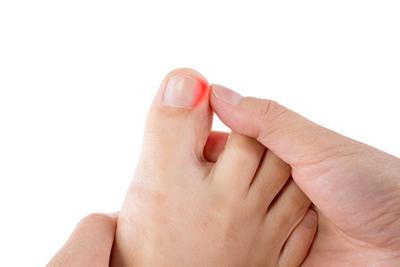A Guide to Preventing Ingrown Toenails

- posted: May 17, 2024
An ingrown toenail refers to a situation in which when the edge of a toenail pierces the surrounding skin, creating pain and related symptoms. According to Dr. Jesse Anderson of AAL Podiatry Associates – with offices in Suffolk and Norfolk, VA, ingrown toenails will most likely impact the big toe; however, the condition can happen to any toe or even more than one toe. A podiatrist is trained to identify the issue and devise a treatment plan to reduce your symptoms.
What Causes Ingrown Toenails?
A toenail may become ingrown due to -
- Poor Nail Trimming Practices – Proper toenail care involves cutting them straight across. The corners can be filed down afterward.
- Genetic Factors - Some people are more susceptible based on genetic makeup.
- Poor-Fitting Shoes – Tight shoes with a narrow toe box can cause pressure that causes an ingrown toenail.
- Structural Considerations – The shape of a nail or foot can contribute to the likelihood of developing an ingrown toenail.
- Trauma – Injuries, like stubbing your toe, can contribute to the development of ingrown toenails.
It is also essential to maintain a proper foot hygiene routine. Keeping feet clean and dry can help avoid infections that may begin with an ingrown toenail.
The Symptoms of Ingrown Toenails
The most common symptoms of ingrown toenails may include one or more of the following –
- Redness/Swelling.
- Pain/Discomfort.
- The surrounding skin may become tender to the touch, and in severe cases, it may harden.
- The ingrown toenail may develop into an infection, causing more intense pain and the potential for pus or discharge.
Treating Ingrown Toenails
In mild cases of ingrown toenails, soaking the affected toe or foot in a warm Epsom salt bath can provide soothing relief and benefits. It's vital to maintain cleanliness and dryness in the affected areas.
If left untreated or improperly managed, an ingrown toenail is likely to develop into a more serious condition - potentially causing an infection, cellulitis (a skin infection), abscess, and more.
In the presence of an infection, a podiatric specialist like Dr. Anderson might recommend a course of oral antibiotic medication or a topical antibiotic as a treatment option. In certain circumstances, surgery may be necessary to achieve the desired results. For such cases, there are minor surgical procedures available that provide relief.
Contact a Leading Norfolk & Suffolk, VA, Podiatrist Near You Today
If you have chronic issues or a variety of painful symptoms related to ingrown toenails, or if you notice signs of infection (i.e., pus, increased redness, swelling, etc.), contact Dr. Anderson or staff member of AAL Podiatry Associates at 757-625-2952 (Norfolk), 757-539-2098 (Suffolk), or online.

- posted: May 17, 2024
An ingrown toenail refers to a situation in which when the edge of a toenail pierces the surrounding skin, creating pain and related symptoms. According to Dr. Jesse Anderson of AAL Podiatry Associates – with offices in Suffolk and Norfolk, VA, ingrown toenails will most likely impact the big toe; however, the condition can happen to any toe or even more than one toe. A podiatrist is trained to identify the issue and devise a treatment plan to reduce your symptoms.
What Causes Ingrown Toenails?
A toenail may become ingrown due to -
- Poor Nail Trimming Practices – Proper toenail care involves cutting them straight across. The corners can be filed down afterward.
- Genetic Factors - Some people are more susceptible based on genetic makeup.
- Poor-Fitting Shoes – Tight shoes with a narrow toe box can cause pressure that causes an ingrown toenail.
- Structural Considerations – The shape of a nail or foot can contribute to the likelihood of developing an ingrown toenail.
- Trauma – Injuries, like stubbing your toe, can contribute to the development of ingrown toenails.
It is also essential to maintain a proper foot hygiene routine. Keeping feet clean and dry can help avoid infections that may begin with an ingrown toenail.
The Symptoms of Ingrown Toenails
The most common symptoms of ingrown toenails may include one or more of the following –
- Redness/Swelling.
- Pain/Discomfort.
- The surrounding skin may become tender to the touch, and in severe cases, it may harden.
- The ingrown toenail may develop into an infection, causing more intense pain and the potential for pus or discharge.
Treating Ingrown Toenails
In mild cases of ingrown toenails, soaking the affected toe or foot in a warm Epsom salt bath can provide soothing relief and benefits. It's vital to maintain cleanliness and dryness in the affected areas.
If left untreated or improperly managed, an ingrown toenail is likely to develop into a more serious condition - potentially causing an infection, cellulitis (a skin infection), abscess, and more.
In the presence of an infection, a podiatric specialist like Dr. Anderson might recommend a course of oral antibiotic medication or a topical antibiotic as a treatment option. In certain circumstances, surgery may be necessary to achieve the desired results. For such cases, there are minor surgical procedures available that provide relief.
Contact a Leading Norfolk & Suffolk, VA, Podiatrist Near You Today
If you have chronic issues or a variety of painful symptoms related to ingrown toenails, or if you notice signs of infection (i.e., pus, increased redness, swelling, etc.), contact Dr. Anderson or staff member of AAL Podiatry Associates at 757-625-2952 (Norfolk), 757-539-2098 (Suffolk), or online.
